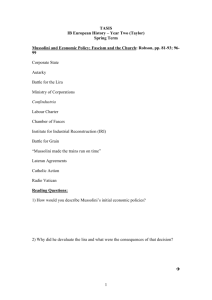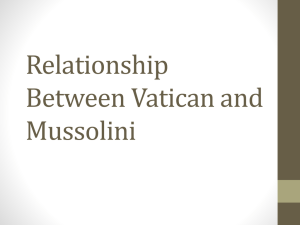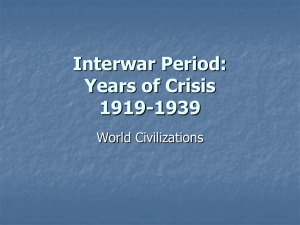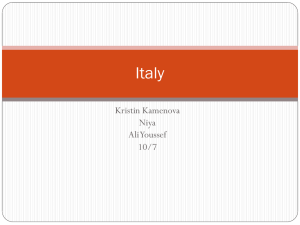Heinemann Chapter Five
advertisement
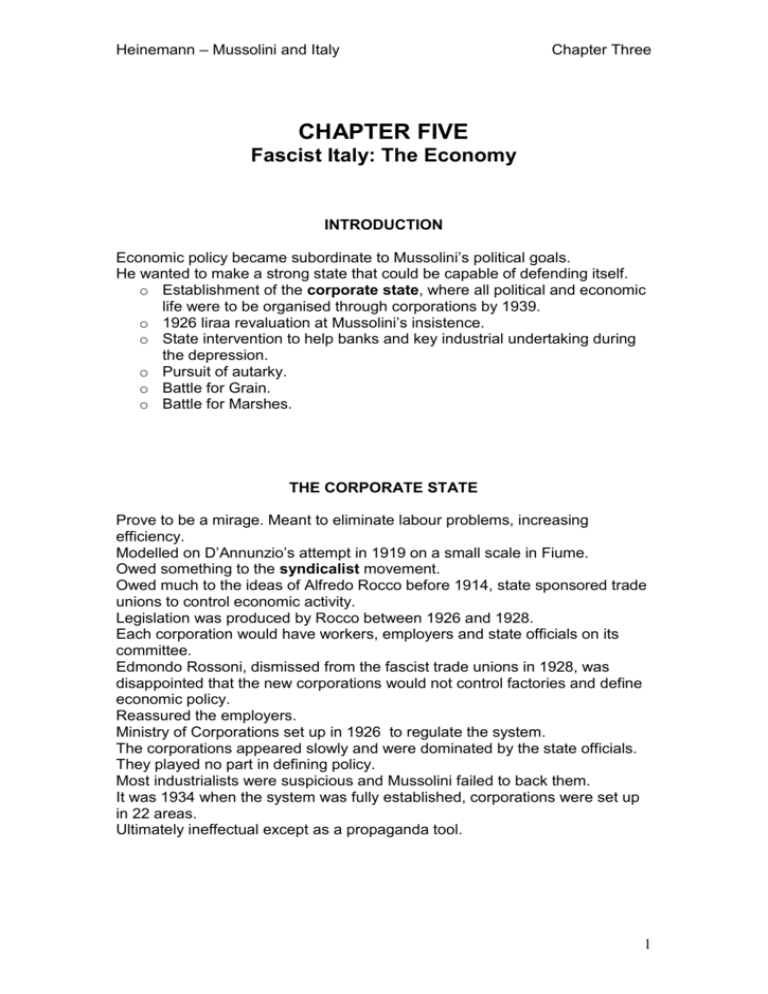
Heinemann – Mussolini and Italy Chapter Three CHAPTER FIVE Fascist Italy: The Economy INTRODUCTION Economic policy became subordinate to Mussolini’s political goals. He wanted to make a strong state that could be capable of defending itself. o Establishment of the corporate state, where all political and economic life were to be organised through corporations by 1939. o 1926 liraa revaluation at Mussolini’s insistence. o State intervention to help banks and key industrial undertaking during the depression. o Pursuit of autarky. o Battle for Grain. o Battle for Marshes. THE CORPORATE STATE Prove to be a mirage. Meant to eliminate labour problems, increasing efficiency. Modelled on D’Annunzio’s attempt in 1919 on a small scale in Fiume. Owed something to the syndicalist movement. Owed much to the ideas of Alfredo Rocco before 1914, state sponsored trade unions to control economic activity. Legislation was produced by Rocco between 1926 and 1928. Each corporation would have workers, employers and state officials on its committee. Edmondo Rossoni, dismissed from the fascist trade unions in 1928, was disappointed that the new corporations would not control factories and define economic policy. Reassured the employers. Ministry of Corporations set up in 1926 to regulate the system. The corporations appeared slowly and were dominated by the state officials. They played no part in defining policy. Most industrialists were suspicious and Mussolini failed to back them. It was 1934 when the system was fully established, corporations were set up in 22 areas. Ultimately ineffectual except as a propaganda tool. 1 Heinemann – Mussolini and Italy Chapter Three FEATURES OF FASCIST ECONOMIC POLICY By 1922 the fascist had abandoned the anti-capitalist ideas of 1919. Any expansion of the party after 1922 was towards the right. 1922-25 Mussolini pursued free-market trade of his predecessors. The economy flourished, partly due to the post-war boom. Exports of goods, particularly cars rose sharply, unemployment fell. Alberto De Stefani was able to cut taxes and achieve a budget surplus until 1925 when the economy took a downward turn. 1924 poor harvest coincided with the lira dropping in value. Italy was at the mercy of economic trends created by the USA, to who the Italians owed vast sums in war debts. This forced Mussolini to implement two of his economic policies. Currency Revaluation – the Quota Novanta 1926 – Mussolini pushed through a sharp revaluation of the lira, from 150 to 90 against the pound. This was a political move, designed to demonstrate a strong Italy. The free market was abandoned and state intervention became common. Effects of Revaluation Hit exports trade but made imports cheaper – benefiting the steel and chemicals industries. These industries allowed for rearmament and allowed for the foreign policy of the 1930s. Tariffs on undesirable imports as consumer goods and foodstuffs kept the prices high and restricted demand. The military adventure to come was being introduced. Propaganda was necessary to persuade workers to accept wage-cuts. This worked very well and often lowered further than living costs, therefore S.O.L decreased. Active State Intervention in the Economy The Depression The government quickly acted to save the banks who had invested in depressed industrial undertakings. Instituto Mobiliare Italiano (IMI) founded in 1931 and Institute for Industrial Reconstruction (IRI) founded in 1933. The government bought both the industrial securities and bank shares. Banks that survived were banned from long term lending, only the IRI agencies could do that. The general consensus was that of success, the actions were better than the European governments who didn’t react. Martin Clark considers Italy survived the depression ‘relatively painlessly’ and that ‘the banking system, although now state ownes, was less vulnerable that before’. After the Depression 2 Heinemann – Mussolini and Italy Chapter Three The government continued an active economic role through ownership of businesses as well as trade policy and import duties. Not a programme of mass nationalisation of the industrial sector. Economy remained in private ownership, with the government working alongside and supporting large private firms. The IRI sold many of its shares to offset the organisation’s costs. 1939 IRI still had dominance, owning the Terni steelworks, Ansaldo shipbuilding works and the L’Italian and Adriatica shipping lines. Bureaucracy State aid did not always benefit the economy, cartels could be formed. State intervention also created a large amount of bureaucracy, operating controls, granting licenses, paper work and creating jobs for party members. The corporations played little part in the central government initiatives. The Aim of Self-Sufficiency (Autarky) This became the most important economic policy from 1930. From 1935, when foreign policy, became more adventurous it became more urgent. Involved heavy industry, particularly armaments. Sough autarky in food supplies, particularly grain. Financial and trade policy were subordinate. Both were used to suppress consumer good demand in favour for heavy machinery and military spending surpluses. After the sanctions it was presented as patriotic. The rearmament resulted in government demand dominating the economy. In the late 1930s between 1/3 and ½ of government spending was on the military (15-21b lira a year) Economic Inefficiency State interference had an adverse effect on efficiency. Higher prices and lower S.O.L. were the results of subsidies and the promotion of monopolies and cartels. Autarky could never be achieved in certain areas, coal, oil, and raw materials for the metal industries. Africa was meant to assist, but this was an incorrect assumption. Autarky could only be achieved with Germany’s help, justify the post 1935 foreign policy. Italy would however always be dependant on its more advanced ally. THE ECONOMY UNDER FASCISM Industry Export industries were badly hit after the revaluation. The car industry used the home market to a good effect, doubling its workforce during the 1930s. This demonstrates rising S.O.L. for some fascists. Steel and chemical industries did well, cheaper coal and iron ore imports. 3 Heinemann – Mussolini and Italy Chapter Three Shipbuilding industry developed with heavy state subsidies. Programme of electrification and roadbuilding relied heavily on state subsidies. Emphasis placed on rearmament and heavy industries resulted in the switching of manufacturing resources to these areas. Agriculture and the Land There were impressive schemes. Large, dramatic projects had great appeal to him. He ignored the north-south divided and the rural poverty. He dreamt of an idealised rural Italy based upon independent, prosperous peasant farmers – he did not aid its coming. Small but inefficient peasant farmers were important supporters. Capitalist farmers of northern Italy were some of his earliest allies. The Battle for Grain, 1925 The purpose of the Battle for Grain was to reduce wheat imports, now subject to high income duties. The farmers of the Po Valley benefited. State provided storage facilities and marketing agencies as well as training courses and publicity campaigns in new production methods. New land areas brought into production, including unsuitable hill land in northern Italy. Late 1930s wheat production was double compared to the early fascist era and 40% higher than the early 1930s. Wheat imports dwindled to next to nothing. Far from an unqualified success. Wheat yields remained low and costs were high compared to France. Much of the new wheat land was in the dry south, where olives and pasture land would be better. Cattle and sheep farming and fruit, especially olive and wine production, declined. They could have been valuable exports, demonstrating the damaging the economic self-sufficiency was having on the country and the S.O.L. Only a success in the autarky aim, also aided northern arable farmers who were strong supporters. Little economic sense, Italy became an importer of olive oil. The Battle for Land 1928 the ‘Mussolini Law’ outlined the regime’s policy on land reclamation. Some drainage plans successful – the Pontine Marsh new rome was by 1935 providing settlement land. Due to its proximity to Rome it provided a propaganda opportunity. Most of the land was lost during the war. Some places there was little success – results fell short of propaganda claims. The works provided work for the unemployed and subsidies for the land owners administering the schemes; however by 1940 it had been abandoned. Effects on the Peasant Farmers. 4 Heinemann – Mussolini and Italy Chapter Three Fascist propaganda stressed the importance on the revival of the rural areas, this was linked to the Battle for Births. It was also designed to alter the pattern of land ownership to benefit the small farmer. Land redistribution failed, inconsistent with the higher profiled Battle for Grain. Subsidies benefited land owners and fewer than 10000 peasant families were resettled on reclaimed land. The call for increased wheat production called for large-scale, machine-based farming methods. The peasants didn’t grow in numbers or prosperity during the fascist period. Except during the depth of the depression migration to towns continued, despite prefects and police being given powers to stop it. With regard to landowning and the revival of rural Italy fascism proved to be a conservative force. 1940 the peasants (90% of the population) owned 13% of the land whilst the richest 0.5% owned over 40% of the land. ASSESSING THE FASCIST ECONOMIC PERFORMANCE The Depression Fascist economic activity spared Italy the worst social and economic effects. The policies safeguarded the banking system, built heavy industries, bolstered large landowning class and made Italy self-sufficient in wheat. The government encouragement to develop the electricity network and road network was important. Growth Despite Government Policy Developments elsewhere owed nothing to government policy. Light engineering growth, paralleling developments in the electrical and motor industries in Europe and US are a good example. Some policies failed, like the battle for grain and land. Some were harmful like the investment in armaments and the high import tariffs protecting inefficient industries at the expense of the Italian consumers. Military Needs Fascism extolled military strength and the economy was directed towards this. The production of consumer goods suffered and the Italian national debt ballooned out of control. 1939 despite all this Mussolini had to confess Italy was not ready for war. By fascism’s own criteria this was a fundamental failure. 5


